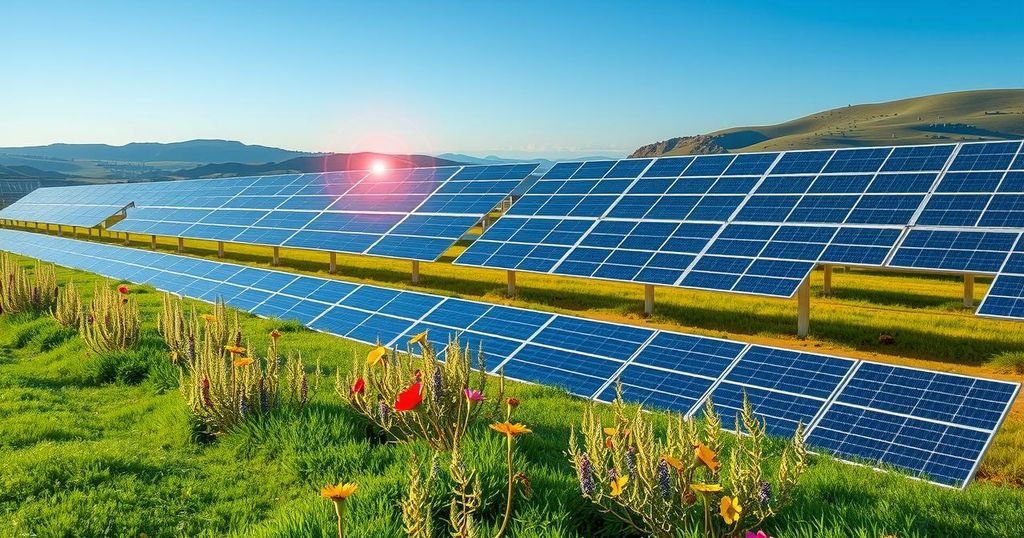Gautam Adani’s legal issues have unveiled critical vulnerabilities in India’s solar sector, impeding clean energy transition efforts. A U.S. corruption case alleges a $265 million bribery scheme tied to Adani’s projects. Despite ambitious energy targets, financial difficulties for state utilities hinder progress, and regulatory weaknesses raise competitive concerns. As India strives for renewable energy expansion, addressing these systemic challenges is imperative for effective climate change mitigation.
Recent legal issues involving Indian tycoon Gautam Adani have shed light on significant challenges within India’s solar energy sector. Adani’s legal troubles, stemming from a U.S. corruption case alleging a $265 million bribery scheme linked to investments, could potentially affect his operations in the renewable energy market. The case illustrates critical vulnerabilities that hinder India’s progress towards sustainable energy solutions and mitigating climate change.
President Donald Trump’s suspension of the Foreign Corrupt Practices Act has raised hopes among some in India that Adani might evade the U.S. allegations. Following this announcement, shares in Adani’s companies experienced volatility, surging initially before declining when the U.S. Securities and Exchange Commission sought cooperation from Indian authorities concerning the corruption case. The repercussions of these allegations have impacted international operations, with Adani withdrawing projects from Sri Lanka and having investment negotiations curtailed in Kenya.
Adani Green Energy, India’s largest renewable energy firm, is developing one of the largest clean power projects in the state of Gujarat, which is projected to generate 30 gigawatts of clean energy, powering approximately 18 million homes. AGEL has set ambitious targets for renewable energy generation, aiming for 50 gigawatts by 2030. However, India’s overall renewable energy sector faces significant financial challenges, particularly within cash-strapped state-owned electricity companies.
India’s state-owned utilities reported losses of $7.8 billion for the fiscal year 2022-23, exacerbated by operational inefficiencies and public resistance to rising electricity prices. Experts argue that renewable energy, while theoretically cheaper than coal, is often perceived by utilities as merely a compliance obligation, hindering transition efficacy. Addressing the financial instability of these state utilities is critical for advancing India’s renewable energy agenda.
The establishment of the Solar Energy Corporation of India (SECI) was intended to mitigate risks for power developers in managing state utility payments. However, allegations surfaced that initial contracts awarded to the Adani Group may have been influenced by corruption. As global initiatives push for increased renewable energy adoption, the contract itself and its management have raised operational concerns regarding administrative costs, contradicting their original cost-reduction intent.
India’s current policies favor large-scale solar developments, limiting the growth of rooftop solar installations and diminishing support for smaller competitors. While the local manufacturing sector for solar components has expanded, domestic production remains costlier than its Chinese counterparts, making it challenging for smaller entities to compete effectively in the market.
The ongoing corruption indictment against Adani has emphasized weaknesses within India’s regulatory environment, revealing tendencies toward cronyism between firms and governmental entities. While many procurement processes adhere to transparency standards, sporadic tendering practices can obscure competition, impacting market fairness and stability.
As India strives to transition from fossil fuels, the slow pace in clean energy adoption poses significant risks, particularly with an expanding population and increasing electricity demands. Despite recent advancements in solar capacity, the actual contribution of solar energy to India’s electricity supply remains disproportionately low compared to global averages. Insufficient storage capabilities further obscure potential buyers’ interest, leading to challenges in striking deals for new solar projects.
The future of India’s solar sector hangs in a delicate balance as it confronts critical structural challenges exacerbated by the recent legal issues surrounding major industry players. The need for a robust regulatory framework, financial stability, and competitive market practices will be essential to achieve India’s clean energy objectives and effectively tackle climate change.
In conclusion, the legal troubles faced by Gautam Adani illustrate the systemic vulnerabilities within India’s solar energy sector, complicating its path towards a sustainable energy future. The interplay of financial challenges within state utilities, potential corruption influences, and regulatory shortcomings contribute significantly to the sector’s challenges. As India aims to boost its renewable energy capacity, addressing these issues will be crucial to harnessing the full potential of solar power in the national and global context.
Original Source: www.independent.co.uk




